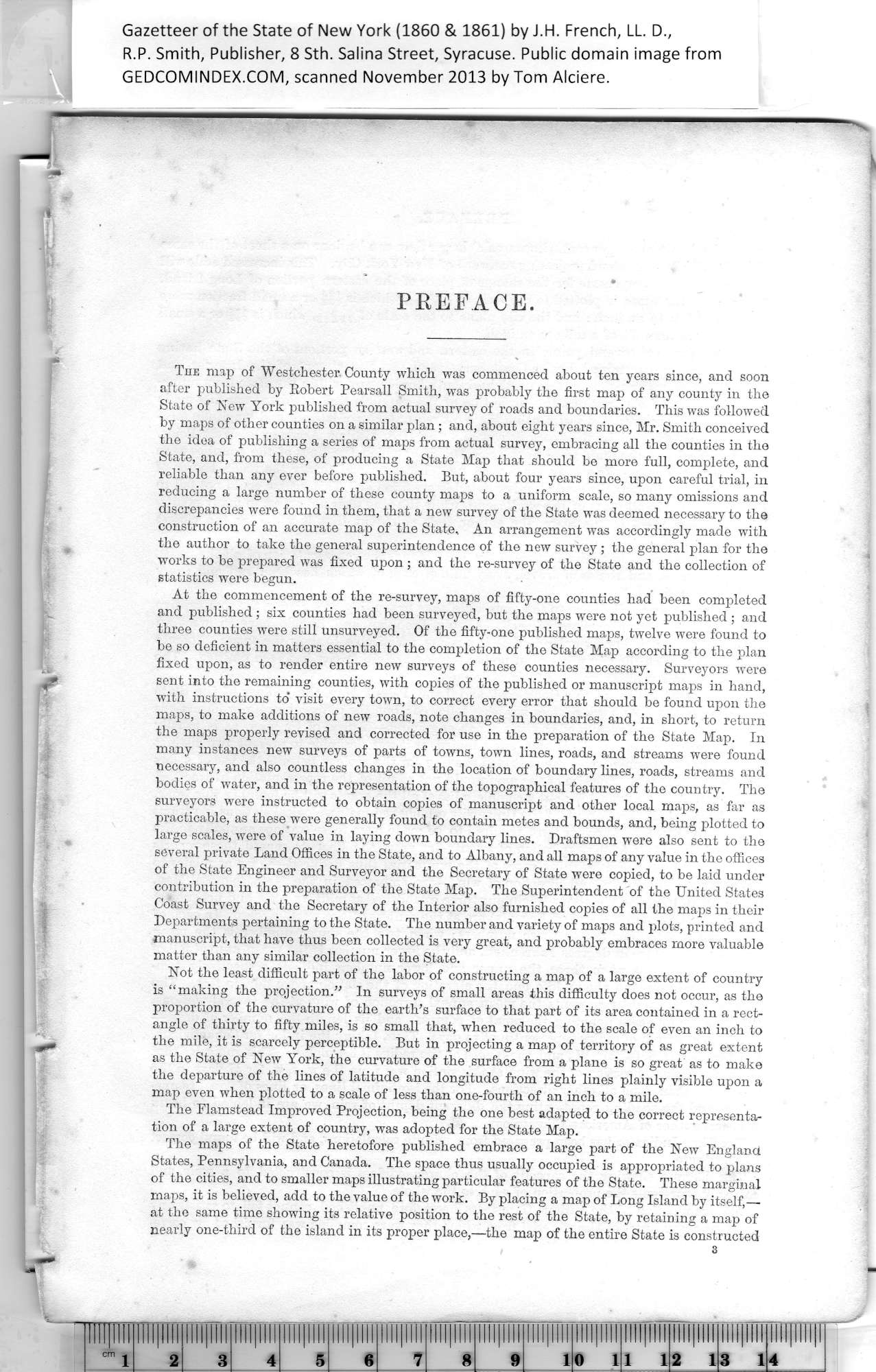|
PREFACE.
The map of Westchester. County which was commenced about ten years since, and soon
after published by Robert Pearsall Smith, was probably the first map of any county in the
State of New York published from actual survey of roads and boundaries. This was followed
by maps of other counties on a similar plan ; and, about eight years since, Mr. Smith conceived
the idea of publishing a series of maps from actual survey, embracing all the counties in the
State, and, from these, of producing a State Map that should be more full, complete, and
reliable than any ever before published. But, about four years since, upon careful trial, in
reducing a large number of these county maps to a uniform scale, so many omissions and
discrepancies were found in them, that a new survey of the State was deemed necessary to the
construction of an accurate map of the State, An arrangement was accordingly made with
the author to take the general superintendence of the new survey ; the general plan for the
works to be prepared was fixed upon ; and the re-survey of the State and the collection of
statistics were begun.
At the commencement of the re-survey, maps of fifty-one counties had been completed
and published ; six counties had been surveyed, but the maps were not yet published ; and
three counties were still Unsurveyed. Of the fifty-one published maps, twelve were found to
be so deficient in matters essential to the completion of the State Map according to the plan
fixed upon, as to render entire new surveys of these counties necessary. Surveyors were
sent into the remaining counties, with copies of the published or manuscript maps in hand,
with instructions to' visit every town, to correct every error that should be found upon the
maps, to make additions of new roads, note changes in boundaries, and, in short, to return
the maps properly revised and corrected for use in the preparation of the State Map. In
many instances new surveys of parts of towns, town lines, roads, and streams were found
necessary, and also countless changes in the location of boundary lines, roads, streams and
bodies of wTater, and in the representation of the topographical features of the country. The
surveyors were instructed to obtain copies of manuscript and other local maps, as far as
practicable, as these were generally found to contain metes and bounds, and, being plotted to
large scales, were of value in laying down boundary lines. Draftsmen were also sent to the
several private Land Offices in the State, and to Albany, and all maps of any value in the offices
of the State Engineer and Surveyor and the Secretary of State were copied, to be laid under
contribution in the preparation of the State Map. The Superintendent of the United States
Coast Survey and the Secretary of the Interior also furnished copies of all the maps in their
Departments pertaining to the State. The number and variety of maps and plots, printed and
manuscript, that have thus been collected is very great, and probably embraces more valuable
matter than any similar collection in the State.
Not the least difficult part of the labor of constructing a map of a large extent of country
is “making the projection." In surveys of small areas this difficulty does not occur, as the
proportion of the curvature of the earth’s surface to that part of its area contained in a rect¬
angle of thirty to fifty miles, is so small that, when reduced to the scale of even an inch to
the mile, it is scarcely perceptible. But in projecting a map of territory of as great extent
as the State of New York, the curvature of the surface from a plane is so great as to make
the departure of the lines of latitude and longitude from right lines plainly visible upon a
map even when plotted to a scale of less than one-fourth of an inch to a mile.
The Flamstead Improved Projection, being the one best adapted to the correct representa¬
tion of a large extent of country, was adopted for the State Map.
The maps of the State heretofore published embrace a large part of the New England
States, Pennsylvania, and Canada. The space thus usually occupied is appropriated to plans
of the cities, and to smaller maps illustrating particular features of the State. These marginal
maps, it is believed, add to the value of the work. By placing a map of Long Island by itself,—
at the same time showing its relative position to the rest of the State, by retaining a map of
nearly one-third of the island in its proper place,—the map of the entire State is constructed
|
